Traditional Flammkuchen, also known as Tarte Flambée, is a German-French ‘pizza’. Think a thin crust topped with creme fraiche, thinly sliced onions and smoked bacon and baked in a wood-fired oven. This Flammkuchen recipe is calibrated to help you bake a delicious traditionally topped flatbread at home.
Go directly to the Recipe Card or
Read on for useful tips and step by step pictures on making the perfect French/German ‘pizza’ (2 mins)
Flammkuchen or Tarte Flambée Origins
Many regard the Flammkuchen or Tarte Flambée as a German pizza. It is a dish of the Alsace region of France and the adjacent Rheinland and Baden-Württemberg regions of Germany.
It originated as just a layer of bread dough, rolled out very thin and baked for a minute or two in the intense heat of a wood-fired oven.
Tarte Flambée translates to a ‘tart/pie baked in flames’ from French. Its German name, Flammkuchen (sometimes Flammekueche), translates to precisely the same – flamme=flame and kuchen=tart.
The two names are used interchangeably given the history, shared traditions and frequently bilingual population of the area.
Make the Dough – Yeast or No Yeast?
As can be expected when a traditional regional dish is concerned there are many, many recipes for the Tarte Flambée dough as well as variations of the toppings.
Traditionally half rye flour and half wheat flour were used and no yeast was added. At the time bread dough was mixed and proofed in large, bacteria rich dough wooden bowls. The micro flora inhabiting the wood fermented the dough.
Many original recipes for Tarte Flambée and Flammkuchen do not call for yeast or call for home brewed beer (with live yeast).
Nowadays however, the dough is frequently leavened with yeast – both in commercial establishments and in home conditions.
Another reason in support of adding yeast is the baking temperature for Flammkuchen. Unless it is baked fast by the intense heat of a wood-fired oven it can dry out excessively over prolonged time in a regular oven and fail to form its landmark crisp-chewy crust.
We recommend that you use a little bit of yeast and proof the dough.
Prepare the Toppings
Ingredients for Flammkuchen
The core ingredients for the traditional Tarte Flambée topping are lean smoked bacon, onions, creme fraiche, nutmeg, salt and pepper.
Often times an egg yolk is added to the creme fraiche and in Alsace fromage blanc (white (to mean ‘fresh’ cheese).The bacon is sometimes pre-cooked in clarified butter. Caraway seeds are typically sprinkled over the Flammkuchen in Germany.
Workflow
- Begin by cutting the smoked bacon into small lardons (cubes or strips). Cook it in a frying pan with a tablespoon of clarified butter (or cooking oil) until it starts to get crisp. Transfer to paper towel lined plate. We recommend that you do this because uncooked smoked bacon will not get crispy enough in a regular oven.
- In the grease left from the bacon soften the thinly sliced onions. They do not need to become caramelized, only soft and translucent.
- Next in a bowl mix the creme fraiche with an egg yolk, nutmeg and salt and pepper.
Creme Fraiche vs Sour Cream
You can use either one but traditionally it is creme fraiche. Sour cream has less fat and tastes more sour than creme fraiche.
Tarte Flambée Shape – Round or Square?
If you visit the regions where Flammkuchen is traditional you will see it presented both round and square. When we lived in Schwarzwald and traveled around the vicinity we noticed that on the same restaurant dotted pedestrian street in Freiburg or Strasbourg you can be served either version, depending on where you happen to sit down.
Smaller, free-form-shaped Flammkuchen are quite common on German beer garden menus and we rather favor those. Great snack food to enjoy with German lagers.
- Once you have all the toppings ready roll out the dough. You can do so in large or small, round or square/rectangular shapes. As long as it is thin.
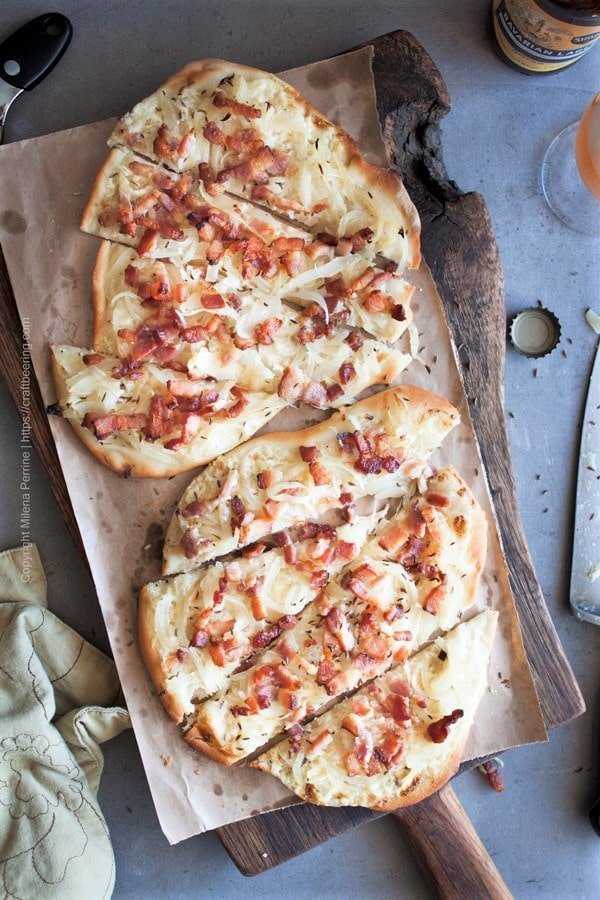
Home oven baked tarte flambee.
Assemble the Tarte Flambée
- Roll out the dough really thin with a rolling pin and place it on parchment paper lined baking sheet.
- Apply the white ‘sauce’ you prepared earlier with a spoon. If you’d like to add fromage blanc (or grated Gruyere or Emmenthal) do it now.
The cream topping of Tarte Flambée should be ivory in color.
- Next place a layer of onions, top with lardons and sprinkle with caraway seeds.
- Bake until the edges of the dough begin to darken. Serve right away, cut into slices. See below for traditional beer and wine pairings.
Traditional Way to Eat Flammkuchen
A long standing tradition is to take a slice of the flammkuchen, roll it onto itself and bite into it. Try it out – it is most satisfying!
Contemporary Toppings/Variations
Being a flatbread at its core today Tarte Flambée is prepared with a variety of toppings beyond the traditional combination. There are even dessert options.
Try these ideas (always include the creme fraiche):
- thinly sliced zuchini
- caraway spiced sauerkraut and sausage
- thinly sliced potatoes and Gruyere
- thinly sliced smoked salmon and spinach
- thinly sliced mushrooms, softened leeks and thyme
- asparagus shavings and prosciutto
- thinly sliced apples covered in cinnamon and sugar
Beer (& Wine) Pairings
- For a suitable beer pairing with your Tarte Flambée look no further than the crisp lagers popular in both Alsace and Southwest Germany, including the dark Dunkel and Schwarzbier. A refreshing Bavarian wheat ale makes a great contender.
- Wine aficionados can delight in pairing Flammkuchen with the regional white wines of Alsace and the Rhineland such as dry Rieslings, Pinot Blanc (Weissburgunder), Pinot Gris and even Gewürztraminer.
Tarte Flambée and Flammkuchen Historical Background
Alsace, today in France, is a rich region with a complicated, turbulent history. In the past there were numerous periods when it was ruled by the predecessors of contemporary Germany. In result German is still spoken there today, as well as several other dialects influenced by both French and German.
Alsace shares a lot of cultural, including culinary traditions with today’s Rheinland and Baden-Württemberg (previously Baden, Palatinate) regions of Germany.
Back in the day bread was baked once or twice a week in large, wood-fired communal ovens.
To test if the temperature is high enough for bread baking, a thinly rolled flatbread would be inserted in the center of the oven, the embers pushed to the side. The intense heat would bake it in matter of a couple of minutes.
The crust on the periphery of the flatbread would frequently get burned by the flames, hence the names – Tarte Flambée/Flammkuchen. Subsequently people started adding toppings to the thin test breads and creme fraiche, onions and lardons became popular in Alsace.
Other Alsatian & Baden-Württemberg Dishes
German Onion Pie
Choucroute Garnie
Kartoffelpuffer
White Asparagus with Hollandaise
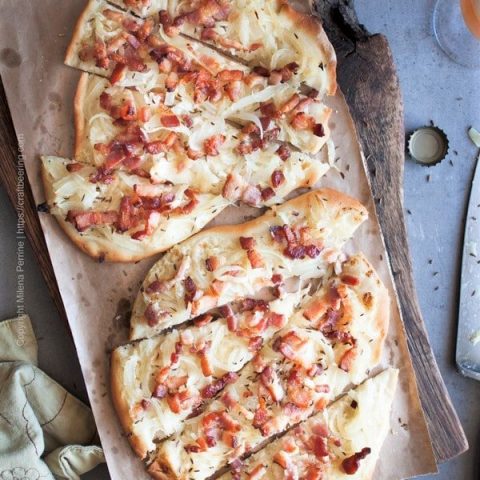
Flammkuchen aka Tarte Flambée (Authentic Recipe)
Tarte Flambée or Flammkuchen (known as German pizza in the US) is a thin flatbread topped with creme fraiche, thinly sliced onions and smoked bacon lardons. Traditionally it is baked at extremely high temperatures in wood-fired ovens. This recipe is designed for baking in a home oven.
Ingredients
Dough
- 2 tsp active yeast, pizza yeast preferred*
- 1/2 tbsp sugar
- 1 cup warm water
- 2 1/2 cups all-purpose flour, (or half rye flour, half all-purpose flour)**
- 1 tsp kosher or sea salt
- 1 tbsp olive oil
Topping
- 1 tbsp clarified butter or cooking oil
- 3 onions
- 6 oz smoked bacon, thick cut, not too fatty
- 7 oz creme fraiche or sour cream
- 1 large egg yolk
- 1 tsp salt
- 1/2 tsp pepper
- 1 tsp nutmeg
- 1 tsp caraway seeds (optional)
Instructions
- Sift the flour. Combine the yeast, sugar and water in a bowl and let the yeast activate.
- Add the flour, salt and oil and mix until a dough forms.
- If using a stand-up mixer, let it work on the dough for a couple of minutes.
- If kneading by hand, knead actively onto a floured surface for 5 minutes.
- Cover the dough and let rest in a warm spot for about 1 hour.
- In the meantime cut the bacon into small, thin strips and thinly slice the onions.
- Heat the clarified butter or cooking oil over medium heat and cook the bacon until it just begins to get crispy. Move it to drain over a paper towel.
- In the same pan with the grease left from the bacon, saute the onions. When translucent move away from the heat and let them cool off.
- Mix the creme fraiche or sour cream with the yolk, salt and pepper, nutmeg.
- Heat the oven to 425 F.
- Knead the dough for a minute and divide it into portions (8 for appetizer sized or 4 for bigger flammkuchen).
- Roll out the dough pieces thinly and place then onto parchment paper lined baking sheets.
- Spread creme fraiche mixture over each tart, top with onions, bacon and sprinkle with caraway seeds. Bake for 20 minutes or until the edges begin to darken.
- Serve right away.
Notes
This recipe yields 4 large individual tarts or 8 smaller appetizer-sized ones. We like making the smaller ones because they seem to bake more evenly in a home oven.
One serving is 2 small or 1 large tart.
If you are short on time feel free to use store bought pizza dough. Bring it to room temperature and roll it out thin as per the recipe.
*If you'd rather not use yeast, also omit the sugar. Combine the sifted flour, salt and 3 tbsp oil (instead of 1) together and slowly add the warm water (most likely will only need 3/4 cup). Mix by hand or use a mixer. Move to floured surface, knead until the dough is elastic and let it rest covered for about an hour.
**Be prepared to add more flour, as needed if dough turns out a bit wet. This is likely if you are located in Europe.
Tarte flambee is traditionally eaten by hand. People commonly roll up large slices and eat them end to end.
Nutrition Information:
Yield: 4 Serving Size: 1Amount Per Serving: Calories: 739Saturated Fat: 15.3gCholesterol: 129mgSodium: 160mgCarbohydrates: 73gFiber: 4.7gSugar: 5.5g

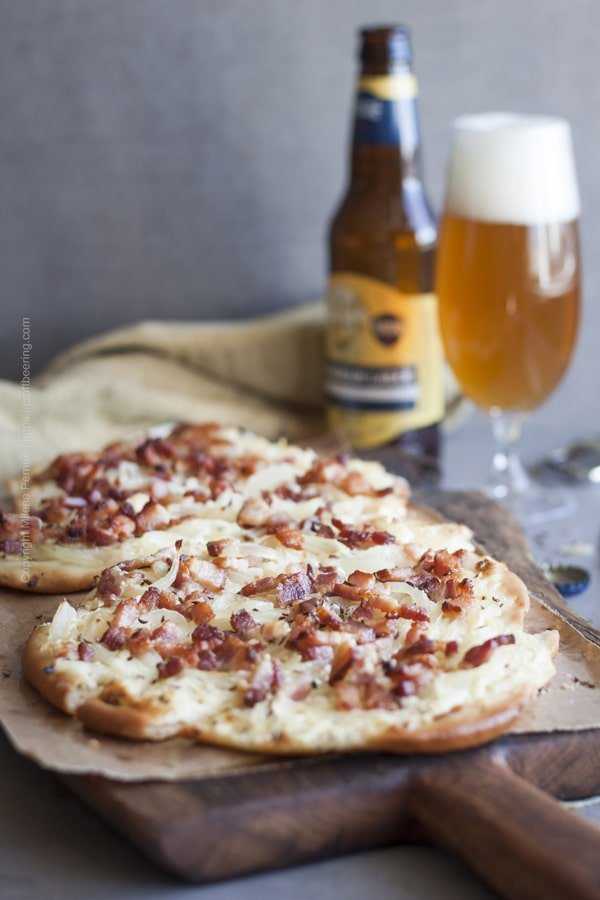
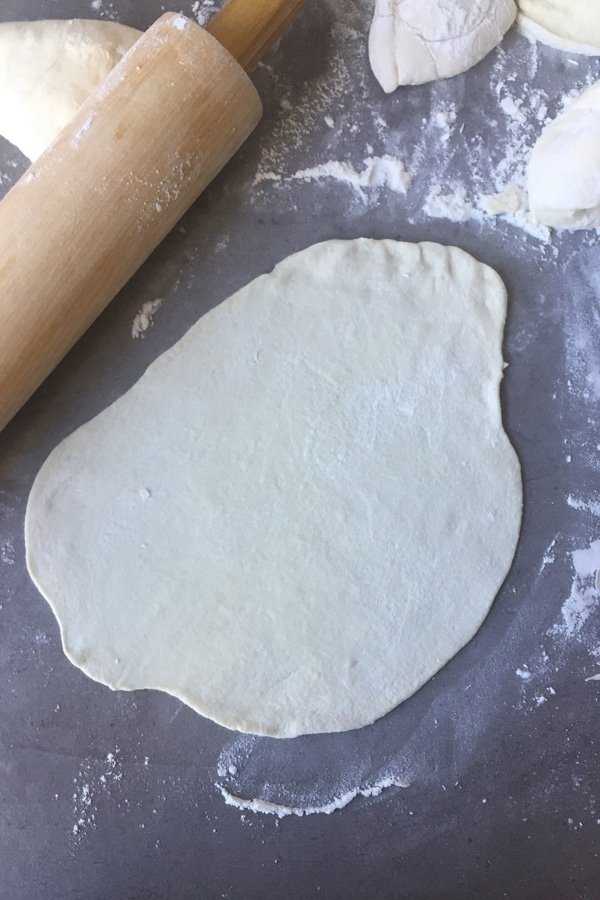
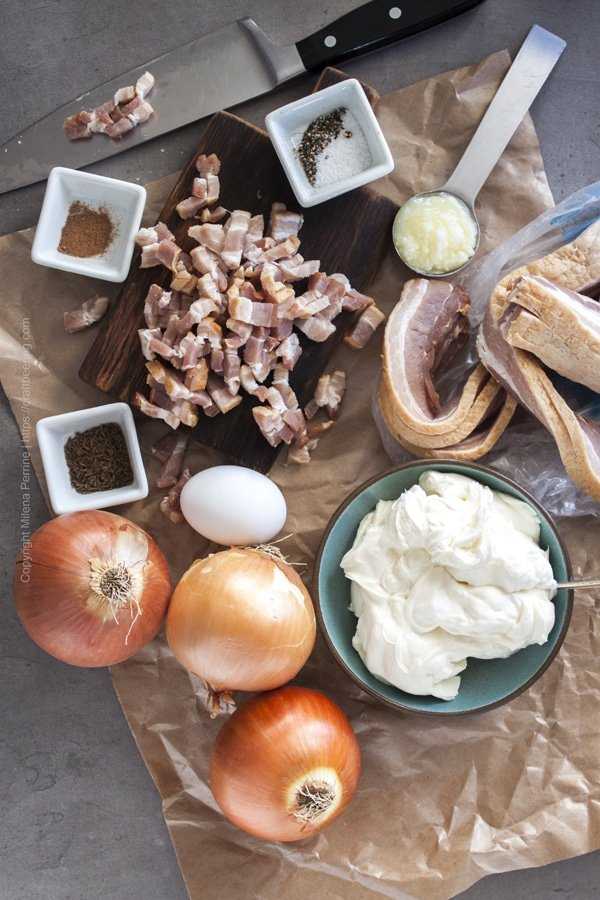
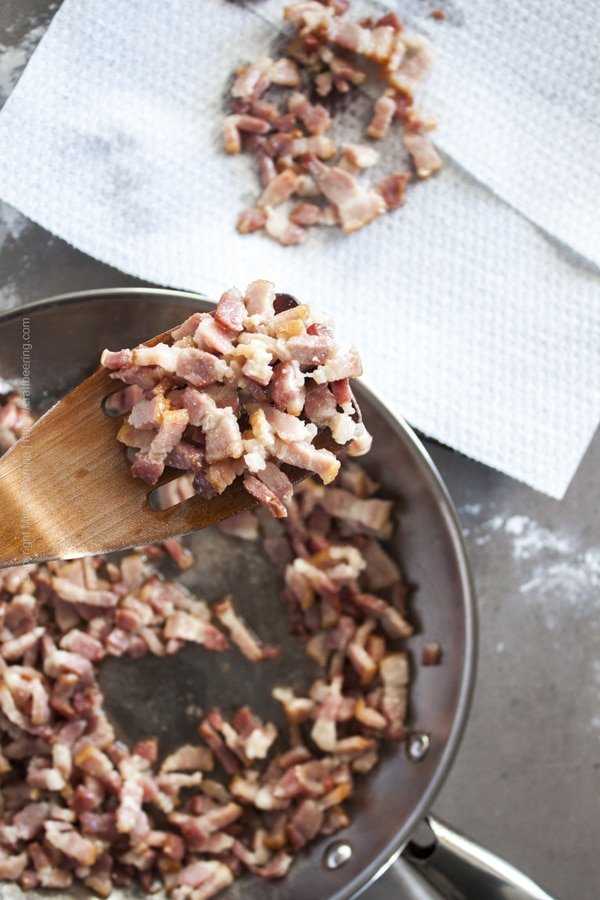
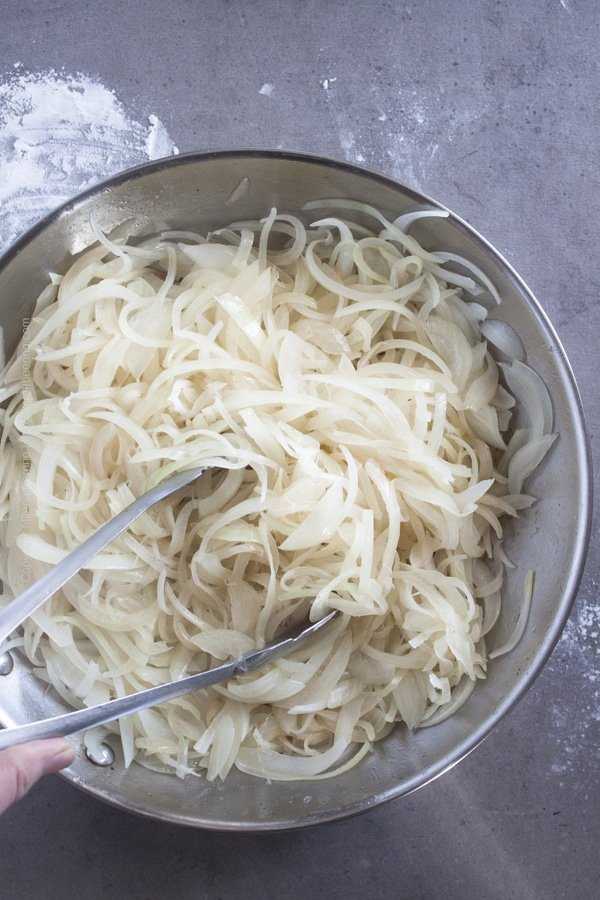
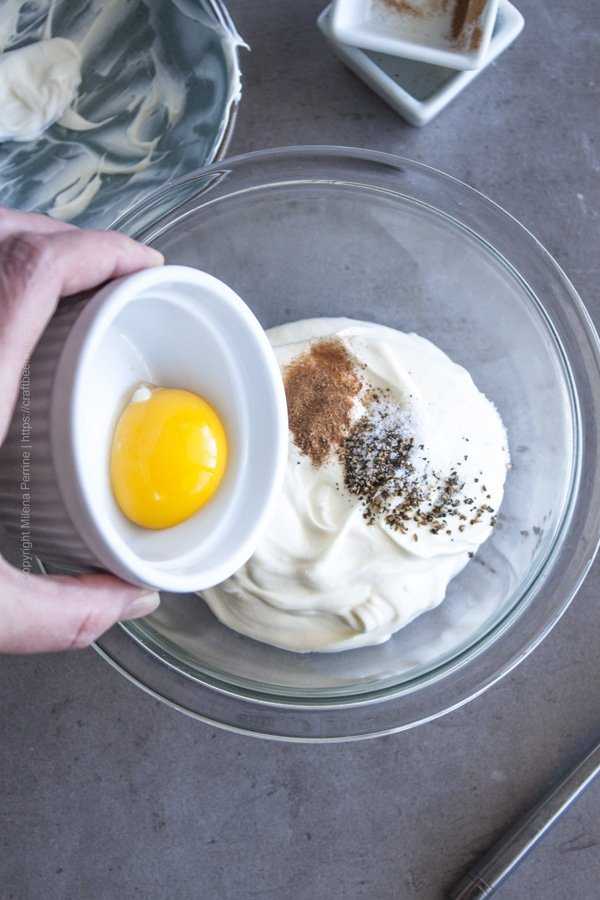
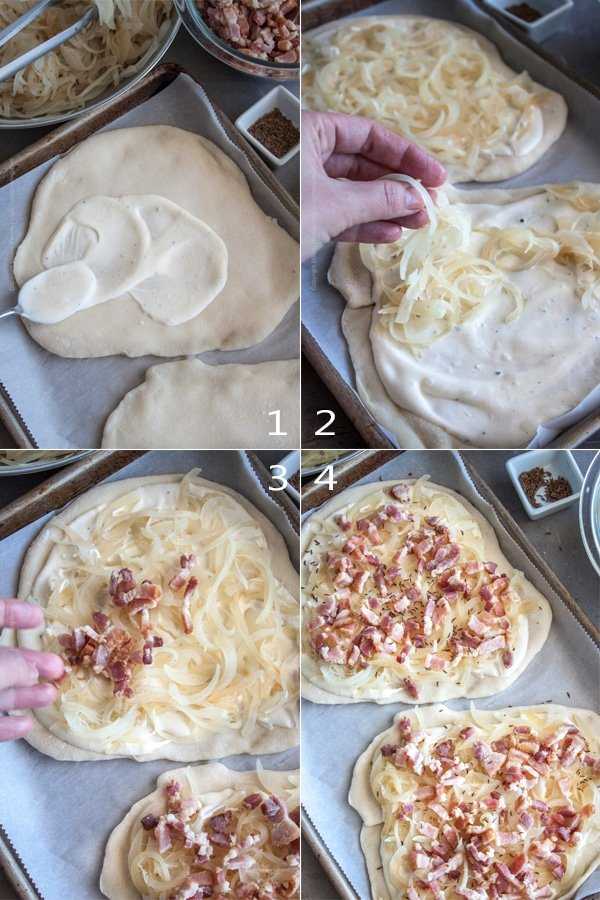
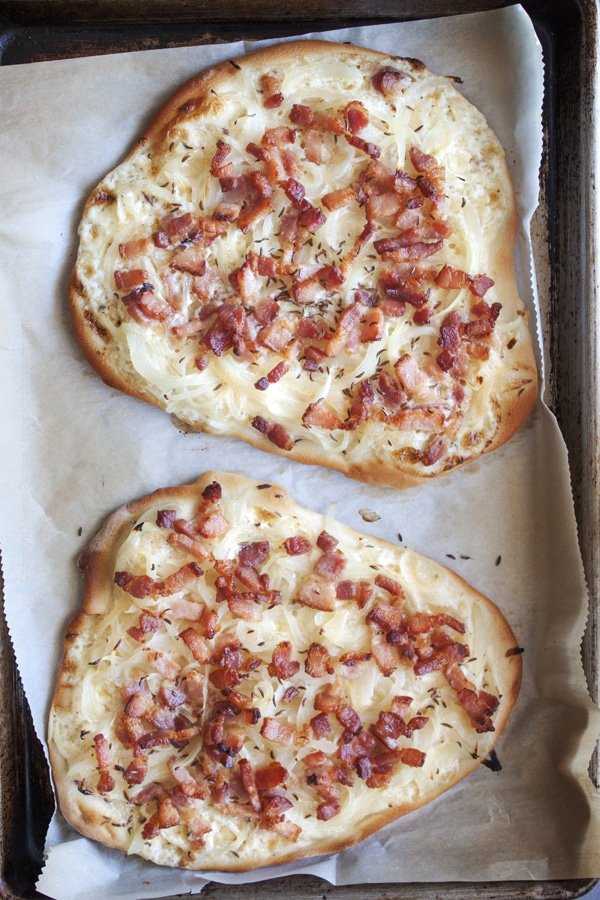
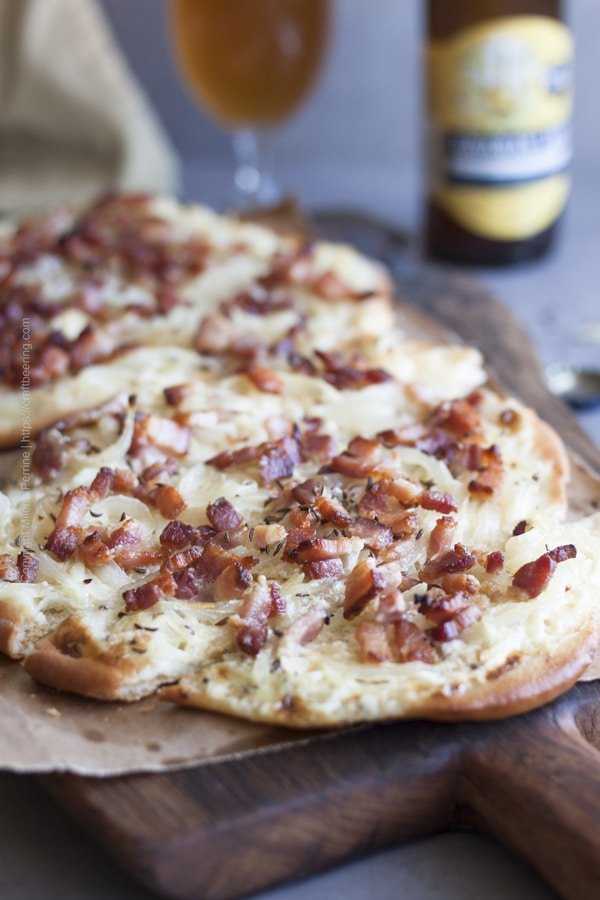
Jenn says
I *literally* just had this at Little Green Rabbit in Berlin a few weeks ago (though not as much onion and they used red). It was SO good! This is getting pinned. =)
Susie says
I’m preparing an elaborate Oktoberfest feast…these are on the menu…I know they are best served right away, but could I parbake them and blast them in a hot oven right before serving? Thanks for a great looking recipe
Milena Perrine says
Absolutely! You can also ‘blast’ them on a hot grill with lid closed, simulating an oven for more genuine flame flavor:)
Mary Kay says
I am looking forward to trying this recipe. I have a friend that has to eat gluten free…could you use flatbread and add the toppings? Thank you
Milena Perrine says
Mary Kay, of course, you can use a recipe for gluten-free flat bread or pizza dough or buy one that is par baked and needs to only receive the toppings.
Joelle Herring says
Do you think it was be possible to make the crust ahead of time and refrigerate?
CraftBeering says
Absolutely, just be sure to cover it well with plastic or even place it in a tightly sealed plastic bag while it is in the fridge. Take it out and leave it at room temperature about 2-3 hours before you prepare the Flammkuchen for baking, the dough will warm up and the yeast will speed up.
Ana says
I went ahead with my instant yeast and made a half batch but the dough was suuuuuper wet. Made another half batch and added about 2/3 of the water called for and it was much better (could this be because there’s a lot of humidity where I live?). Anyway, overall a pretty easy and massively delicious recipe. Tasted very close to the ones I had in Switzerland. Thank you!!
CraftBeering says
Glad to hear, Ana! It seems that because US flour is mostly GMO with higher gluten content when you use European wheat flour or even Asian, more flour is necessary. We personally use 00 flour, but most people don’t so this recipe works best with US all-purpose flour.
Ana says
This was one of the few flammkuchen recipes I found in English – very excited to try it. I am a beginner bread/dough maker though and can only find instant yeast here in Spain. How would I account for that? Skip the first step and mix it with the flour, salt, oil + 1c water? Thank you!
CraftBeering says
Hi, Ana! If you can find cubed yeast which is more common in Europe (I think lavadura fresca in Spain), then you can make a little starter with 1/4 cup flour, yeast about the size of 1 cm cube and a bit of water, mixed. After it begins to bubble proceed with the recipe (the 1/4 cup flour should come out of the total flour for the recipe). Otherwise you can make it without yeast, but really need to allow the dough to rise from the actions of bacteria naturally found in the air where you are. Homes where people bake lot have a lot of yeast, bacteria etc. floating in the air and their dough rises faster. So I think it is best to use yeast when first starting to make dough, any baking yeast will do.
French Dude says
Hi, I am French-born and studied for four years in Strasbourg. At least flavor-wise, my first attempt with your recipe was spot on. That was the only thing we could afford, just the cream and the onion, everything else came at additional cost. That was 30 years ago, and I would say they always came on these rectangular wood boards on wooden communal wooden tables, very low key environment. Drinks were typically basic Kro since it was cheaper than water. You would pile the boards and count them at the end of the meal to know how much you owed.
I am Parisian born, so I may be very wrong, but I think there is a little too much water and yeast in the quantities for the dough. Maybe that is the German version, but I remember something thinner and yet that’s true something you could roll. As for the water, it makes the dough too sticky to handle. I went for three cups of flour, and the transfer of a 15′ pie to a pizza peel was really easy gently rolling the dough around the rolling pin. Other technique would be to fold the dough in half, then in half again with flour to transfer it.
I haphazardly found some smoked gruyère, probably from California, and it was actually very good. The cheese was of course milder that the real think, but the smoked flavor enhanced the fried bacon. I would definitely cook the bacon in advance in the USA. I got some very bad bits, but rendered it at medium heat, trying to get the fat out to cook the onions and it worked out well.
After 16 minutes on a pizza stone at the bottom, I felt the toppings were good enough, the egg the nutmegg, and the cream mix, added to the cheese was just perfect. European ovens can both bake and broil at the same time, but that seems too complicated around here, so next time I’ll preheat the pizza stone in the middle of the oven, then set it to broil when I put the tarte in so that it can burn.
In any case, thank you, I would say this recipe is very close to the real thing, and definitely taste like the real thing. Maybe even better since there is so much pig fat to render the onions?
If links are allowed, here is my version:
qrieux.smugmug.com/Other/Food/FoodShots/i-FKGf55m/A
Thank you for a good evening. I paired it with a good reisling from france. It would pair well with PBR.
CraftBeering says
Thank you for your comments, input and especially your account of real life memories and experiences, always fascinating! Your tips are much appreciated and hopefully others who stop by will take them into consideration. It is hard to replicate an iconic food from Europe, we find that the flour is the biggest problem in the case of the dough for Tarte Flambee. European flour is not GMO, less gluten, more nutrients and so much better performing. We always have better results when we use OO flour or US cake flour, but are aware that most people will just buy AP and tried to make the recipe easy to follow for what we assume will be the most logical of circumstances. So glad to hear that you enjoyed the Tarte Flambee you made. We love Strasbourg and have been several times, will be back there soon, it is very special.
Sabrina Lim says
Super happy with this recipe. It’s my first attempt and as good, if not better than the ones I had in Germany. This a definitely a keeper! Thank you for sharing!
CraftBeering says
So great to hear, thank you, Sabrina!
Rita says
Real deal flavors!
Donna Luis says
Saving this recipe. Tasted just like the ones I remember from our trip to France. Will be making it again. Thank you for sharing how to make the creme fraiche.
annie@ciaochowbambina says
Flavors to write home about!! There’s nothing here that I don’t love!! Thanks for sharing!
Kerryanne says
Gosh, I always learn so much from your guys. I’ve not heard of this recipe before, but can already see it will be a winner in our household!!
Thank you for sharing at Create, Bake, Grow & Gather this week. I’m delighted to be featuring this recipe at tonight’s party and pinning too.
Hugs,
Kerryanne
Marvellina | What To Cook Today says
My kids recently have a thing for onion and homemade pizza. This, I think will definitely go down well with them, not just because of the onion, but the bacon, the cream fraiche. Love that you share how to make our own cream fraiche because it’s not always easy to find it, at least where I am. Love how easy it is to make too. I agree on the yeast, I like somehow like a yeasted dough 🙂 that texture is just different.
Dawn - Girl Heart Food says
‘Tart pie baked in flames’, huh? I’ve never heard of this before, but now that I know about it, I HAVE to try! Sounds absolutely delicious! Love the idea of asparagus on there too. Pinned!
CraftBeering says
Thank you, Dawn! Yes, pretty delicious:)
Kelsie | the itsy-bitsy kitchen says
I’ve never heard of flammkuchen but I love anything that involves bread dough :). And I love the option of topping it with caraway seeds–soooo good! Have a great weekend!
CraftBeering says
Thank you, Kelsie! We are also huge fans of caraways seeds.
Jennifer @ Seasons and Suppers says
Love this! There is a restaurant I have visited several times that serves these and now I can make them at home, too 🙂
CraftBeering says
This is awesome! I wish we had one around where we could order a Flammkuchen. But fortunately they are easy to make:)